Fashion is, however, a necessity in many people’s daily lives, with clothes reflecting their personality, culture or way of life. Ever thought how the so-called ‘ready-to-wear’ outfits we wear in our day-to-day lives are designed? Every process involved in the fashion industry on the creation of these apparels , right from the selection of fabric to the completion of the apparel, reveals a lot about the quality and esthetic value of the apparels.
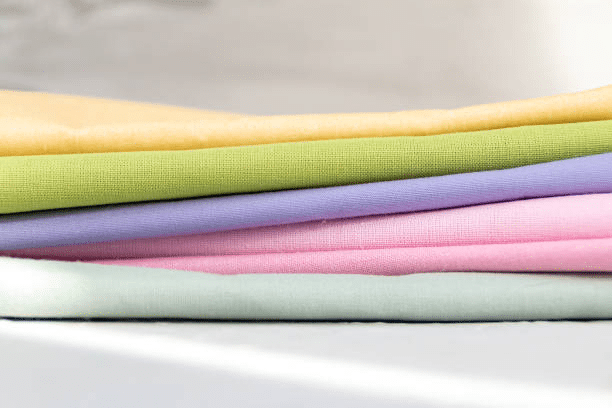
It is time to take a closer look at the complex process of garments production and reveal the greatest information regarding how clothes are created, starting from the fabric and ending with the final result.
Fabric Production: From Seed to Fabric
Starting from the seed up to the cloth used for making the apparels, the process is quite exhaustive. Every procedure, right from the cultivation of raw materials to processing the fiber, weaving the fabric and finally completing the garment, uses both conventional and scientific methods.
Cultivation of Raw Materials
The clothing production of fabrics entails the growing of raw materials, which include plants and animals.
- Cotton is one of the most universal fiber materials which are produced and cultivated in the territories with rather warm climate, The plants are irrigated and in need sun light.
- The production of wool begins with the farming of sheep that are trimmed one or two times a year, and the fleece is gathered. This explains why some wools may be more superior than others, depending on the breed of the sheep and the attention they are given.
- Silk fabric is made from silkworms that weave cocoons of silk filaments from a material called mulberry. This process entails the planting of mulberry trees because their leaves are the diet of the silkworms.
Harvesting and Processing
The acquisition of raw materials for spinning requires going through more steps. The following are the steps that are followed in the acquisition of the raw materials.

- Cotton is separated from seeds, washed, cleaned, pressed into bales, and taken to textile mills.
- Grease wool is washed and scoured to take out dirt and lanolin, followed by carding to ensure the fibers are parallel.
- Sericulture workers immerse silk cocoons in washing so that they can soften sericin, which is a natural gum that binds the fibers. The long silk filaments are then unwound and reeled on spools or any means of winding the silk carefully.
Spinning
Spinning is another vital process that forms yarn or thread from the processed fibers and dictates the fabric’s strength and feel. Cotton fibres are bundled up, and these are twisted to make yarns. Today’s advanced machinery can spin different types of yarns, from thin to thick and from low to good quality.
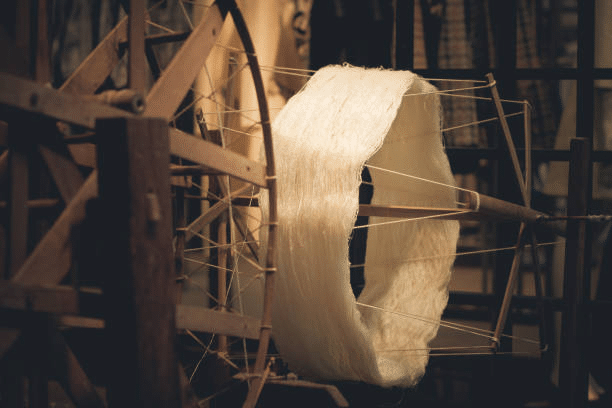
The woolen fibers are processed by worsted or woolen processes to give a smooth, attractive yarn for cloth, tough yarn or soft, fluffy yarn, as the case may be. Some of the individual filaments that make up the silk are grouped to form threads; this process needs to be done carefully so as not to cut off the fibers’ length.
Weaving and Knitting
Subsequently, the spun yarn is used in knits and weaves to bring about various weaves fabrics. Weaving is the process of intertwining two or more ends of yarns perpendicular to one another at right angles with the help of a loom, which results into different textures and characteristics.
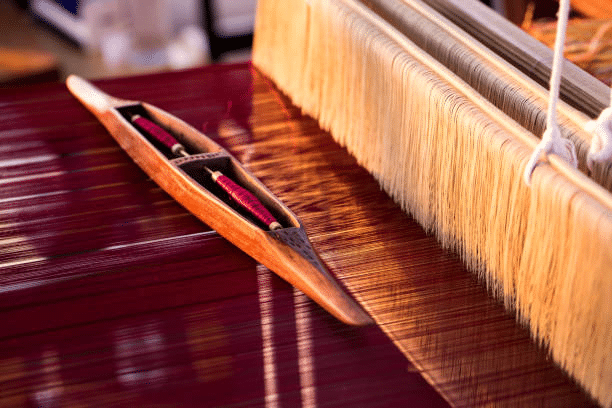
Sewing is the joining of fabric, clothing, or materials through stitching, which can be used more rigidly and is more formal than knitting, such as pants, shirts, dresses, etc. Some of the weaving structures, which include the plain structure, the twill structure, and the satin structure, create distinct fabric feels.
Dyeing and Finishing
Fabrics are produced and altered through dyeing and finishing techniques to enhance the fabric’s looks, touch or functionality. Dyeing entails the use of natural and synthetic dyes based on the type of fiber and the fabrics usage.
Bleaching, printing, and chemical treatment, which are employed at the last stage of fabric manufacturing, improve the fabric’s sturdiness, waterproof nature, or feel, depending on the sort of fabric and its application.
Cutting and Sewing
The over stitched fabric is then further cut into garments. Designers mark the layout of each design or picture on the cloth, which is then used as a guide to trim the fabric into that shape. The components are then joined by stitching by either other artisans or by machines, with the attachment of accessories such as buttons, zippers and other trims.
The Manufacturing Process
The production of garment manufacturing includes a series of steps including clothing pattern design, pattern making, cutting, sewing, finishing, pressing and packaging.
1. Pre-Production Processes in Garment Manufacturing
The pre-production processes in garment manufacturing include conception, design, drafting, specification and material selection.
The initial step includes rough designing a concept based on trendy fashion or influence in society. The design is finely tuned, and features that include seams darts, pockets and embellishments are incorporated.
Flats are prepared after the design is finalized and they are the blueprints of how the construction should be done.
Buying of fabrics entails finding the suppliers, examining samples with regard to quality, endurance, resistance to fading, and touch amongst others and bargaining for large quantities. Fabrics go through a series of test to meet performance standard and specifications for apparel production like shrinkage, color fastness, and strength.
2. Pattern Making and Cutting
Pattern Making
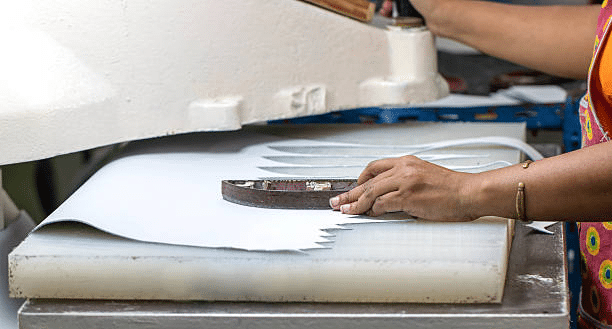
Pattern maker entails developing templates for fabric pieces that are to be cut out as well as the subsequent arrangement of the pieces in making clothing. Since fit is important, measurements all have to be very precise for pattern makers, so use standard size charts or design and make a pattern to order—for the type of body or for a particular client.
- It primarily entails sketching the whole pattern and then mapping the seam allowance, darts, pleats, and other aspects of the garment.
- Muslin or toile testing involves sewing a garment with cheap fabric just to check the form of the pattern and to alter it.
- This process is commonly used in grading, which involves enlarging or reducing a given size in the range of the standard sizes so that the proportion of the size and the fit are preserved.
Cutting process
The cutting process comes after the paper patterns have been developed and the latter approved. Pieces are placed on the fabric selection based on their grainlines and identified pattern lines for the ideal hang of the part and overall design. The cutting tools can be hand tools or computerized, depending on the fabric and the design of the garment or product.
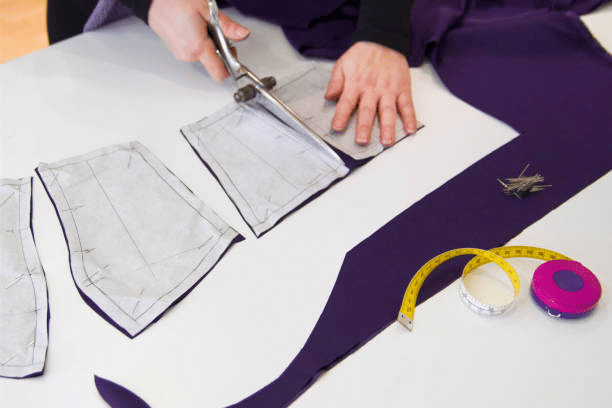
Makers of the cutters place some signs on the material that indicate where to sew, the pattern to be followed, or points of contact between the parts to be joined. They are carried out before and after cutting to confirm the correctness, check for imperfections, and ensure compliance with certain standards in developing garments.
3. Sewing and Assembly line
The cutting room trims fabric for garmenting, which is taken to the sewing and assembly section for joining. This step entails joining all the components to make the dress and may incorporate cuffs, belt loops, or pockets, among others.

The fabric pieces are cut and transported to the sewing section thru the use of flat lock sewing machine where tailors and seamstresses use machinery, a serger, or handmade sewing machine techniques to join the fabrics to create clothes, put in zippers, buttons, ornaments, etc., and finish.

Sewing is one of the main techniques in the construction of apparel; however, other methods like adhesive bonding, heat sealing, ultrasonic welding, and tape bonding are more often used. These methods provide better esthetic outcomes, but to be utilized in garment factories, they need to be appropriate for certain garments and fabrics to yield satisfactory results.
4. Pressing and Finishing
To give the garments a professional look, they are ironed and trimmed. This step entails washing, ironing, or pressing the garments from the wardrobe to remove all wrinkles and present clean, shining garments. Also, at this stage, each and every slipper is checked for any flaws, holes, seams, loose threads, or any other small defects that may be present.
5. Quality Control and Assurance
The following are some of the key aspects that you have to factor in so that you can have the best quality control on garments:
a. Garment Quality Assurance
QA in garments is thus the science of designing, implementing, and monitoring strategies for enhancing the quality of garments. It seeks to minimize variations and mistakes in an organization at the material selection, manufacturing, product assembly, packaging and distributing stages.
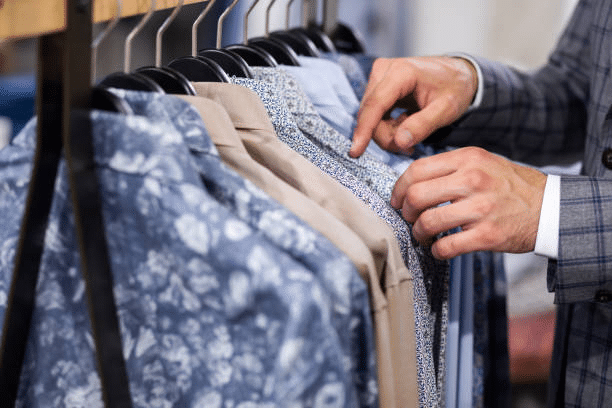
These are quality planning and management, process control, supplier and contractor assessment and approval, testing and inspection, and quality improvement activities.
b. Ensuring High-Quality Garments Through Testing and Inspection
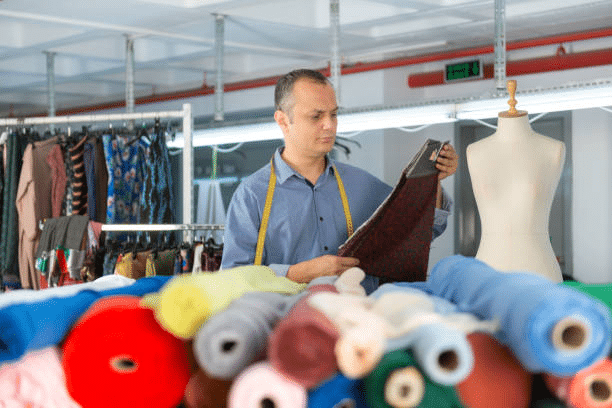
There are several processes that constitute the process of quality control.
- The first is Raw Material inspection, that confirms the quality and specifications of the raw materials, such as fabric, trims and accessories, to be used in the production process.
- The second one is In-Process inspection, where, when the process is going on, it is checked and controlled to ensure the detection and correction of any defect.
- The third quality check method is the Final Product inspection, which assesses the quality of the finished garments to meet clients’ expectations.
- The fourth is Quality Audits and Compliance, which is defined as the assessment of the QA/QC procedures, conformity to the QMS, and legal compliance.
6. Production Planning and Delivery

a. Production Planning and Cutting for Efficient Production
Scheduling of garment production is an essential activity that is required in the manufacturing of garments so as to avoid congestion and delays. Some of the outstanding activities include order analysis, acquisition of materials, time management, cutting strategy, work distribution and control of quality. Order analysis includes studying the customer’s orders to identify the quantity, required standards, and time constraints.
Material procurement helps to have the material in supply and also takes into account the stock of the material. Scheduling develops the production schedules of the orders according to importance and availability. Marking and planning in addition to cutting, such as marker making, CAD, and automated machines sharpens the edge, reduces material waste, and speeds up the process.
b. Handling the Legal Part of Clothing Manufacturing
It is important that the clothing manufacturers adhere to the laws founded on legal grounds, as they are affecting the ethical manner, protection of the given property, and governmental laws and regulations of the modern garment manufacturers. Some of the major factors that need to be taken care of include registration of the business organization, the protection of intellectual property rights, labor intensive process and regulations, environmental laws and regulations, and contracts.
Businesses are also subject to registration of its units each contract, the receipt of necessary licenses and permits, and labor legislation. Environmental compliance includes aspects of waste disposal, energy usage, and sustainability. To avoid being on the wrong side of the law, it is crucial that one gets acquainted and updated with the limits set within the relevant clothing manufacturer.
c. Textiles Labeling Requirements and Regulations
Chamness (2006) noted that branding and printing of garments are very essential since they meet the legal requirements, inform consumers, and create reliability and credibility for the garments. There are a variety of labels, which include the fiber content, care label, country of origin, size and fit, and safety label.
Conformance is done to gain the confidence of consumers, avert fines, and minimize poor quality and non-compliance with children’s wear and flame-resistant clothing.
7. Post-Production and Marketing
Taking into account the steps in the clothing line entrepreneurship, namely packaging, distribution, promotion, sale, customer relations, and service, the perfect launch will be discussed in the context of the main strategies and techniques.
Packaging and Shipping: Preparing Garments for Distribution
It is important to have well-designed packaging in that it creates an impression that customers will have upon unboxing the product. Sourcing the best fabric that represents the brand and the durability of the garments by protecting them during transportation. Make sure that garments do not look careless; they must be properly ironed and all the additional labels affixed properly.
Select reliable shippers so that goods are delivered on time, and ensure you provide tracking information. It may also be important to adopt environmentally friendly packing techniques and materials when appealing to conscious clients.
Marketing and Sales Strategies for Clothing Lines
To create a market presence and generate more sales, develop the right marketing and sales plan by targeting its consumers, e-business, and physical outlets, setting up the company image, planning for advertising and special offers, and effective consumer relations through entertaining content, emails, rewards, and individual approaches.
Customer Service and Feedback Loop for Continuous Improvement
It is also important to add that the key feature of a successful clothing line is its ability to provide clients with great service. This includes interactive communication, improved quality of the product, the acquisition of customer feedback, and constant customization.
Paying immediate attention to customers’ inquiries and complaints, guaranteeing that the garments they ordered are of high quality, simplifying the returns and exchange processes, and proactively asking customers through polls, reviews, and posts on social media how they can improve customer satisfaction and encourage repeat business.
8. Launching the Clothing Line: Planning and Execution
To launch a clothing line, determine the specific objectives, consumers, cost, and time frame you will be willing to undertake. Talk about it before it’s out through teaser campaigns, sneak peek campaigns, and influencer collaborations. Organize an event to launch and market the collection, such that media people will focus attention on it.
Leverage owned media such as social platforms and websites and paid media like e-mail newsletters and internet ads, and finalize SEO. Maintain and/or modify the performance indicators in order to make the most of development and continue the success further after the product launch.
Packing and dispatching your products well, promoting your line, selling, and customer management, along with a perfect plan and execution of a launch, can lead your clothing line to greater heights in the fashion business.
Conclusion
To trace the process of turning fabric into a garment, it is important to know that this process is a step-by-step and very carefully planned and orchestrated activity of artistry, skill, technology, and quality control. All of these steps involved in the process contribute towards the actualization of clothing that not only looks fashionable but also serves the intended purpose and is of good quality. That information provides an understanding of the work that is put into the creation of the clothes, most of which are considered and appreciated daily.
